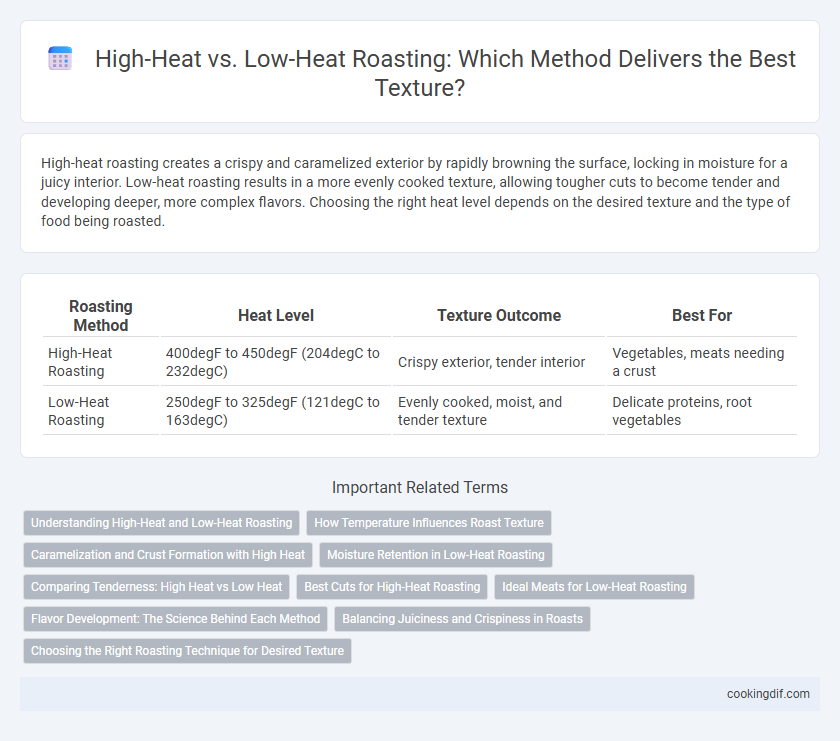High-heat roasting creates a crispy and caramelized exterior by rapidly browning the surface, locking in moisture for a juicy interior. Low-heat roasting results in a more evenly cooked texture, allowing tougher cuts to become tender and developing deeper, more complex flavors. Choosing the right heat level depends on the desired texture and the type of food being roasted.
Table of Comparison
| Roasting Method | Heat Level | Texture Outcome | Best For |
|---|---|---|---|
| High-Heat Roasting | 400degF to 450degF (204degC to 232degC) | Crispy exterior, tender interior | Vegetables, meats needing a crust |
| Low-Heat Roasting | 250degF to 325degF (121degC to 163degC) | Evenly cooked, moist, and tender texture | Delicate proteins, root vegetables |
Understanding High-Heat and Low-Heat Roasting
High-heat roasting, typically between 400degF to 450degF, creates a crisp, caramelized exterior by rapidly searing food while locking in moisture. Low-heat roasting, around 250degF to 325degF, cooks food slowly and evenly, producing tender, juicy textures by gently breaking down connective tissues. Understanding these temperature ranges helps optimize texture and flavor for various meats and vegetables in roasting recipes.
How Temperature Influences Roast Texture
High-heat roasting at temperatures above 400degF creates a crisp, caramelized exterior with a tender and juicy interior by rapidly sealing moisture inside. Low-heat roasting around 275degF to 325degF results in a uniformly cooked texture, promoting tenderness and even doneness throughout the roast. The choice of temperature directly influences Maillard reaction intensity and moisture retention, which are critical factors for achieving desired roast texture.
Caramelization and Crust Formation with High Heat
High-heat roasting excels in caramelization, creating a deep, flavorful crust that enhances texture through the Maillard reaction. This method rapidly browns the exterior while sealing in juices, resulting in a crisp, golden crust. Low-heat roasting produces a more uniform doneness but lacks the intense caramelized crust that high heat achieves.
Moisture Retention in Low-Heat Roasting
Low-heat roasting preserves moisture by slowly heating the food, preventing rapid water evaporation and maintaining a tender texture. This method allows proteins and fibers to break down gradually, resulting in juicier and more succulent roasted items. High-heat roasting, while crispy, often leads to faster moisture loss, creating drier textures.
Comparing Tenderness: High Heat vs Low Heat
High-heat roasting rapidly caramelizes the surface, creating a crispy crust while potentially toughening the exterior but locking in moisture for a tender interior. Low-heat roasting promotes even cooking throughout, resulting in uniformly tender meat with a softer texture but less pronounced crust development. The choice between high and low heat significantly influences the balance between surface crispiness and overall tenderness in roasted dishes.
Best Cuts for High-Heat Roasting
High-heat roasting enhances texture by quickly searing the exterior, creating a flavorful crust while sealing in juices, ideal for tender cuts like ribeye, sirloin, and tenderloin. Low-heat roasting promotes even cooking and tenderness over time but may not develop the same caramelized crust. Choosing high-heat roasting for premium, well-marbled cuts maximizes flavor and texture by balancing a crisp exterior with a juicy interior.
Ideal Meats for Low-Heat Roasting
Low-heat roasting excels with tender, evenly marbled meats like pork loin, beef tenderloin, and whole chickens, preserving moisture and ensuring a supple texture. This method gently breaks down connective tissue over time, ideal for prime cuts that benefit from slow, steady cooking. Maintaining internal temperature precision prevents dryness and enhances the natural juiciness of these delicate proteins.
Flavor Development: The Science Behind Each Method
High-heat roasting rapidly triggers Maillard reactions and caramelization, intensifying complex flavors and creating a crisp, textured crust. Low-heat roasting allows enzymes to break down proteins and fats gradually, enhancing tenderness and developing subtle, nuanced flavors with a juicier interior. Understanding the thermal dynamics and chemical processes of each method helps optimize flavor profiles and achieve desired textures in roasted foods.
Balancing Juiciness and Crispiness in Roasts
High-heat roasting caramelizes the surface quickly, creating a crispy exterior that locks in juices, resulting in a satisfying textural contrast. Low-heat roasting evenly cooks the meat, preserving tenderness and juiciness but producing a less crisp crust. Balancing these methods by starting with high heat and finishing at low heat optimizes texture, achieving both a juicy interior and a crispy outside in roasts.
Choosing the Right Roasting Technique for Desired Texture
High-heat roasting rapidly sears the exterior, creating a crispy, caramelized crust while preserving a juicy interior, ideal for meats and vegetables needing a crunchy texture. Low-heat roasting allows gradual cooking, ensuring even texture and tenderness by breaking down connective tissues and retaining moisture, perfect for delicate cuts and root vegetables. Selecting the right roasting technique depends on the desired texture outcome, where high heat offers crispness and low heat delivers softness and uniformity.
High-heat vs low-heat roasting for texture Infographic

 cookingdif.com
cookingdif.com